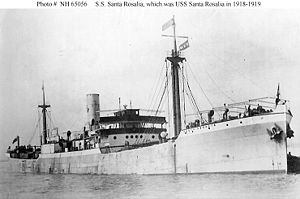USS Santa Rosalia (ID-1503)
 SS Santa Rosalia prior to her U.S. Navy service. | |
| Career (United States) | 100x35px |
|---|---|
| Name: | USS Santa Rosalia |
| Namesake: | Previous name retained |
| Builder: | William Hampton and Company, Ltd., Port Glasgow, Scotland |
| Launched: | 21 September 1911 |
| Completed: | October 1911 |
| Acquired: | 20 May 1918 |
| Commissioned: | 20 May 1918 |
| Decommissioned: | 26 June 1919 |
| Fate: | Transferred to United States Shipping Board for simultaneous return to owners 26 June 1919 |
| Notes: |
In commercial service as SS Santa Rosalia 1903-1918 and 1919-1929, and as SS Stefanos Costomenis 1929-1936 Foundered 18 February 1936 |
| General characteristics | |
| Type: | Cargo ship |
| Tonnage: | 5,409 gross tons |
| Displacement: | 11,500 tons |
| Length: | 419 ft 0 in (127.71 m) |
| Beam: | 52 ft 7 in (16.03 m) |
| Draft: | 24 ft 7 in (7.49 m) (mean) |
| Propulsion: | triple expansion steam engine, one shaft |
| Speed: | 10 knots (maximum) |
| Complement: | 62 |
| Armament: |
1 x 5-inch (127-millimeter) gun 1 x 3-inch (76.2-millimeter) gun |
USS Santa Rosalia (ID-1503) was a United States Navy cargo ship in commission from 1918 to 1919.
SS Santa Rosalia was built at Port Glasgow, Scotland, by William Hampton and Company, Ltd. as a commercial cargo ship. Launched on 21 September 1911, she was completed in October 1911. The United States Steel Products Company of New York City purchased her in 1914. After the United States entered World War I in 1917, the U.S. Navy inspected her for possible naval service sometime in 1917 or 1918. The United States Shipping Board chartered Santa Rosalia for World War I service on 20 May 1918 and transferred her to U.S. Navy control. The Navy assigned her the naval registry Identification Number (Id. No.) 1503 and commissioned her the same day as USS Santa Rosalia at New Orleans, Louisiana.
Assigned to the Naval Overseas Transportation Service, Santa Rosalia departed New Orleans on 1 June 1918 for Hampton Roads, Virginia, where she loaded general United States Army supplies. Steaming in convoy for France on 19 June 1918, she reached Brest, France, on 9 July 1918 and proceeded to Gironde to discharge her cargo. She got underway for the United States on 3 August 1918 and arrived at Baltimore, Maryland, on 20 August 1918.
On 26 August 1918, Santa Rosalia headed for New York City for repairs before departing Norfolk, Virginia, in convoy for Europe early in October 1918. She reached Brest on 28 October 1918,then proceeded to St. Nazaire, France. On 11 November 1918, while Santa Rosalia was unloading her cargo there, the armistice with Germany was signed, ending World War I.
Santa Rosalia got underway for Baltimore on 14 November 1918 and arrived there on 5 December 1918. After transferring from a U.S. Army to a United States Shipping Board account, she proceeded to New York to take on a cargo of general supplies. She stood out to sea on 19 January 1919, arriving at St. Thomas in the United States Virgin Islands on 25 January 1919. On 27 January 1919, she departed St. Thomas for Montevideo, Uruguay, where she arrived on 18 February 1919. After unloading there, she took on a cargo and returned to New York. She again returned to New York, from a similar round-trip voyage to Montevideo on 6 June 1919.
Santa Rosalia was decommissioned at New York on 26 June 1919. She was transferred to the United States Shipping Board the same day for simultaneous return to the United States Steel Products Company.
The ship returned to commercial service as SS Santa Rosalia. United States Steel Products sold her in 1929 to E. G. Culucundis and Costomeni of Syros, Greece, which renamed her SS Stefanos Costomenis.
During a voyage from Tampa, Florida, to Rotterdam, the Netherlands, with a cargo of phosphates, Stefanos Costomenis was abandoned and foundered on 18 February 1936.[1]
Notes
- ↑ NavSource Online at http://www.navsource.org/archives/12/171503.htm claims that the ship sank off the coast of "North Russia," but it is difficult to understand how the ship came to be off the Soviet Union's north coast during a voyage from Tampa to Rotterdam.
References
- This article includes text from the public domain Dictionary of American Naval Fighting Ships. The entry can be found here.
- Department of the Navy: Naval Historical Center Online Library of Selected Images: Civilian Ships: S.S. Santa Rosalia (American Freighter, 1911). Served as USS Santa Rosalia (ID # 1503) in 1918-1919.
- NavSource Online: Section Patrol Craft Photo Archive: Santa Rosalia (ID 1503)
